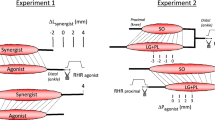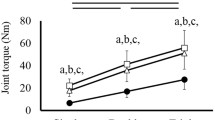Summary
-
1.
The mechanical arrangement and transducing properties of Golgi tendon organs in soleus and anterior tibial muscles of anesthetized cats have been studied by noting responses of their Ib afferents to muscle stretch (passive force) and contraction (active force) of small portions of the muscle including functionally isolated motor units.
-
2.
Tendon organs were shown to be arranged both in-series and in-parallel with adjacent muscle fibers. There were gradations in these relations, the tightest arrangements involving the response to contraction of a single motor unit, brisk discharge from an in-series receptor and pause in the stretch-activated firing of an in-parallel receptor. Other arrangements included those in which groups of muscle fibers neither directly in-series nor in-parallel with a receptor were still found capable of influencing its firing pattern. If in-series muscle fibers maintained their contraction while in-parallel fibers were also contracting, the receptor usually responded slightly less actively than it did to the in-series force alone.
-
3.
Tendon organs were found to have a very low threshold to in-series force developed by muscle contraction. Responses were observed to as little as 0.5 gm of twitch tension. Minimum active force thresholds were similar for the two muscles studied, but thresholds to dynamic stretch were lower for anterior tibial receptors. Division of the dynamic stretch threshold by the minimum active force threshold gave a measure of the extent to which each tendon organ was more sensitive to active than passive force. These values (generally less than 50) did not negate the physiological significance of responses to passive stretch.
-
4.
The present data, together with those of Houk and his co-workers (1967, 1971) emphasize that tendon organs can participate in the moment to moment reflex control of normal muscle activity.
Similar content being viewed by others
References
Alnaes, E.: Static and dynamic properties of Golgi tendon organs in the anterior tibial and soleus muscles of the cat. Acta physiol. scand.70, 176–187 (1967).
Barker, D.: The innervation of skeletal muscle. In: Myotatic, Kinesthetic and Vestibular Mechanisms, pp. 3–15. Ed. by A.V.S. De Reuck and J. Knight. Boston: Little, Brown and Co. 1967.
Boyd, I.A., Davey, M.R.: Composition of peripheral nerves. Edinburgh-London: Livingstone 1968.
Brandstater, M.E., Lambert, E.H.: Motor unit anatomy: type and spatial arrangement of muscle fibers. Fourth Internat. Congress Electromyography, Brussels Abstracts pp. 10–11, 1971.
Bridgman, C.F.: The structure of tendon organs in the cat: A proposed mechanism for responding to muscle tension. Anat. Rec.162, 209–220 (1968).
Brown, M.C., Matthews, P.B.C.: An investigation into the existence of polyneuronal innervation of individual skeletal muscle fibers in certain hind limb muscles of the cat. J. Physiol. (Lond.)151, 436–567 (1960).
Buller, A.J., Lewis, D.M.: The rate of tension development in isometric tetanic contractions of mammalian fast and slow skeletal muscle. J. Physiol. (Lond.)176, 337–354 (1965).
Cruz, I., Hufschmidt, H.J.: Golgi-sehnenorgane und spinale Koordination der Motorik beim Kaninchen. Electromyographische Untersuchungen. Pflügers Arch. ges. Physiol.275, 121–133 (1962).
Eccles, J.C., Eccles, R.M., Lundberg, A.: Synaptic actions on motoneurones caused by impulses in Golgi tendon organ afferents. J. Physiol. (Lond.)138, 227–252 (1957).
Eccles, R.M., Lundberg, A.: Synaptic actions in motoneurones by afferents which may evoke the flexion reflex. Arch. ital. Biol.97, 199–221 (1959).
Edstrom, L., Kugelberg, E.: Histochemical composition distribution of fibers and fatigability of single motor units. J. Neurol. Neurosurg. Psychiat.31, 424–433 (1968).
Ekstedt, J.: Human single muscle fiber action potentials. Acta physiol. scand.61, Suppl. 226 (1964).
Engberg, I., Lundberg, A.: An electromyographic analysis of muscular activity in the hind limb of the cat during unrestrained locomotion. Acta physiol. scand.75, 614–630 (1969).
Granit, R., Pompeiano, O., Waltman, B.: The early discharge of mammalian muscle spindles at onset of contraction. J. Physiol. (Lond.)147, 399–418 (1959).
Green, D.G., Kellerth, J.-O.: Intracellular autogenetic and synergistic effects of muscle contraction on motoneurons. J. Physiol. (Lond.)193, 73–94 (1967).
Hongo, T., Jankowska, E., Lundberg, A.: The rubrospinal tract. II. Facilitation of interneuronal transmission in reflex paths to motoneurones. Exp. Brain Res.7, 365–391 (1969).
Houk, J.C.: A visco-elastic interaction which produces one component of adaptation in responses of Golgi tendon organs. J. Neurophysiol.30, 1482–1493 (1967).
Houk, J.C., Henneman, E.: Responses of Golgi tendon organs to active contractions of the soleus muscle of the cat. J. Neurophysiol.30, 466–481 (1967).
—, Simon, W.: Responses of Golgi tendon organs to forces applied to muscle tendon. J. Neurophysiol.30, 1466–1481 (1967).
Houk, J.C., Singer, J.J., Henneman, E.: The adequate stimulus for tendon organs with observations on the mechanics of the ankle joint. J. Neurophysiol. (In press) (1971).
Huelsman, L.P.: Handbook of Operational Amplifier Active RC Networks. Burr-Brown, Tucson 1966.
Hunt, C.C., Kuffler, S.W.: Stretch receptor discharges during muscle contraction. J. Physiol. (Lond.)113, 298–315 (1951).
Jansen, J.K.S.: On the functional properties of stretch receptors of mammalian skeletal muscles. In: Myotatic, Kinesthetic and Vestibular Mechanisms, pp. 20–34. Ed. by A.V.S. De Reuck and J. Knight. Boston: Little, Brown and Co. 1967.
—, Rudjord, T.: On the silent period and Golgi tendon organs of the soleus muscle of the cat. Acta physiol. scand.62, 364–379 (1964).
Lundberg, A.: Reflex control of stepping. Nansen Memorial Lecture to Norwegian Academy of Sciences. Oslo: Universitetsforglaget 1969.
Matthews, B.H.C.: Nerve endings in mammalian muscle. J. Physiol. (Lond.)78, 1–53 (1933).
Matthews, P.B.C.: Muscle spindles and their motor control. Physiol. Rev.44, 219–288 (1964).
McPhedran, A.M., Wuerker, R.N., Henneman, E.: Properties of motor units in a homogeneous red muscle (soleus) of the cat. J. Neurophysiol.28, 71–84 (1965).
Mills, L.W., Swett, J.E.: A convenient temperature control system for acute animal preparations. EEG and clin. Neurophysiol.17, 435–437 (1964).
Mosher, C.G., Gerlach, R.L., Stuart, D.G.: Motor units of cat soleus and tibialis anterior muscles. In preparation (1972).
— —, Reinking, R.M., Stuart, D.G.: Properties of anterior tibial tendon organs. Physiologist13, 266 (1970a).
—, Stuart, D.G., Gerlach, R.L., Reinking, R.M.: Relative sensitivity of soleus and anterior tibial tendon organs to active and passive forces. Trans. Amer. neurol. Ass.95, 288–291 (1970b).
Norris, F.H., Irwin, R.L.: Motor unit area in a rat muscle. Amer. J. Physiol.200, 944–946 (1961).
Rack, P.M.H., Westbury, D.R.: The effects of length and stimulus rate on tension in the isometric cat soleus muscle. J. Physiol. (Lond.)204, 433–460 (1969).
Roberts, T.D.M.: Neurophysiology of Postural Mechanisms. New York: Plenum Press 1967.
Stuart, D.G., Goslow, G.E., Mosher, C.G., Reinking, R.M.: Stretch responsiveness of Golgi tendon organs. Exp. Brain Res.10, 463–476 (1970a).
—, Mosher, C.G., Gerlach, R.L., Reinking, R.M.: Selective activation of Ia afferents by transient muscle stretch. Exp. Brain Res.10, 477–487 (1970b).
—, Goslow, G.E., Mosher, C.G., Gerlach, R.L., Reinking, R.M.: Transducing properties and mechanical arrangement of soleus tendon organs. Anat. Rec.166, 385 (1970c).
Stuart, D.G., Mosher, C.G., Gerlach, R.L., Reinking, R.M.: Properties and central connections of tendon organs with special reference to locomotion. In: Research Concepts on Muscle Development and the Muscle Spindle, pp.139–166. Ed. by B. Banker, R. J. Pryzbylsky, J. Van Der Meulen and M. Victor. Amsterdam: Exerpta Medica.
Swett, J.E., Eldred, E.: Distribution and numbers of stretch receptors in medial gastrocnemius and soleus muscles. Anat. Rec.137, 453–460 (1960).
— —, Buchwald, J.S.: Somatotopic cord-to-muscle relations in efferent innervation of cat gastrocnemius. Amer. J. Physiol.219, 762–766 (1970).
Author information
Authors and Affiliations
Rights and permissions
About this article
Cite this article
Stuart, D.G., Mosher, C.G., Gerlach, R.L. et al. Mechanical arrangement and transducing properties of Golgi tendon organs. Exp Brain Res 14, 274–292 (1972). https://doi.org/10.1007/BF00816163
Received:
Issue Date:
DOI: https://doi.org/10.1007/BF00816163




